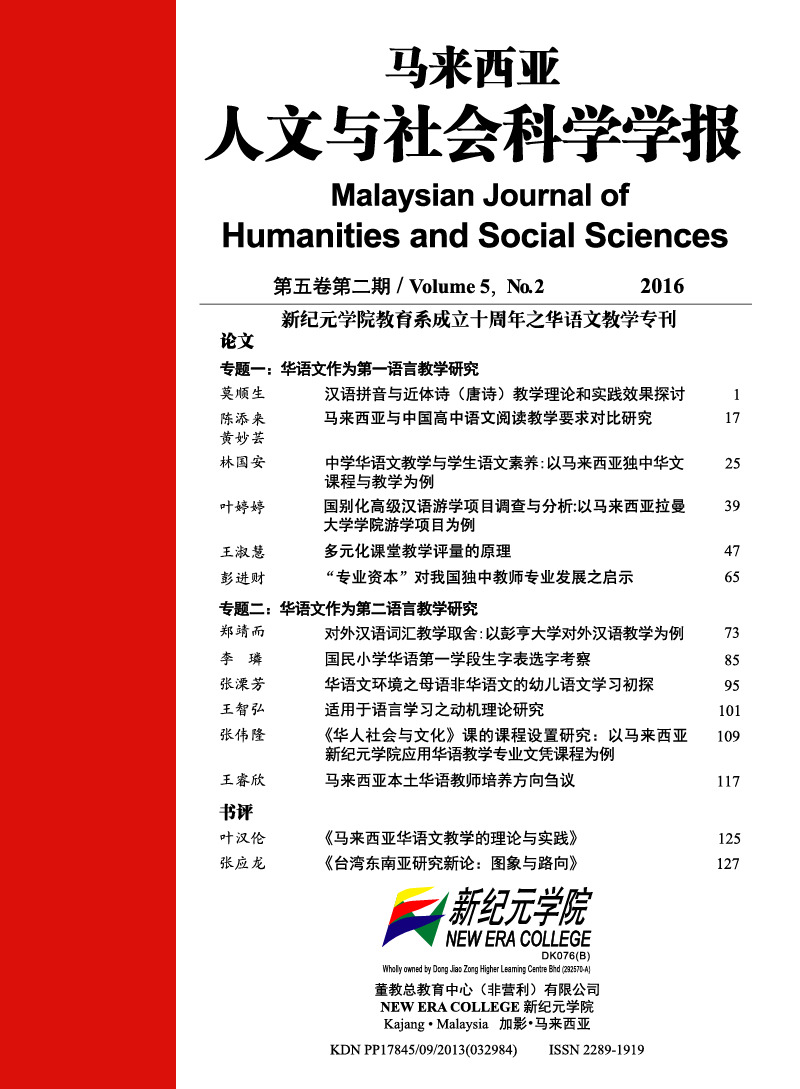汉语拼音与近体诗(唐诗)教学理论和实践效果探讨 The Use of Pinyin and Tang Poetry: The Theory of Teaching and Its Practical Effects
Keywords:
汉语拼音、平水韵、平仄格律、近体诗, Chinese Pinyin, Ping Shuiyun, metrical forms, modem style poetryAbstract
现今的大马教育对近体诗(唐诗)教学,无论是师范学院的课程或是独中和国中以及小学的华文教师和学生都没有给予关注和重视。究其因由,除了对唐诗价值认知不深,不了解唐诗教学有助提升学习华文兴趣和语文程度,以及塑造中华优秀文化的价值观,主要的是基千唐诗的平仄格律难懂难学,尤其是现代的汉语拼音有不少常用字的语音与唐音都不尽相同;因此,用现代汉语拼音诵读唐诗,不但会拗口不顺畅,也失去音韵的和谐,抑扬顿挫之悦耳动听的声调。
唐诗教学既然对弘扬诗教,承传和发扬中华优秀艺术文化如此重要,我们就不能因为唐诗难学难教便放弃我们的责任,而宜设法改变以往枯燥无味的背诵教学方式,配合现代语文教学的理论,来激励初学者的兴趣,采用“一、三、五不论”的教学理论来取代背诵平仄格律,来帮助他们易于掌握唐诗的基本“格律”和“押韵”,以强化“教”与“学”的效果。故本论文主要是探讨如何克服唐诗“教”与“学”的问题,并提出一套有效的教学法,以加强对唐诗的认知和价值,同时能帮助华校师生易于掌握唐诗的基本平仄格律以及标准朗诵的技巧。
上述的建议包括如何克服汉语拼音(新韵)和唐音(平水韵)的入声差异的问题,如何激发学习唐诗的热忱和兴趣,以及如何采用不需背诵平仄格律的教学法来教导学习唐诗,重新掀起对唐诗“教”与“学”的兴趣和重视。
随着大马教育部课程发展中心于2011 年发布的小学标准课程纲要,在每一年级中引进10首近体诗诵读吟赏,作为华文教师应把握契机,学习掌握唐诗教学技巧,激励学生学习的热忱和兴趣,引导他们欣赏和朗诵近体诗,让学生了解学习近体诗的意义和价值,培养他们对读唐诗的喜爱,为承传发扬中华优秀的艺术文化作出贡献。
Malaysian education today has paid scant attention to the teaching of Tang poetry, whether in the schools syllabus or among teachers and students in Chinese independent or government primary and secondary schools. More than the shallow understanding of the value of Tang poems, it should be realized that the teaching of Tang poetry helps to stimulate an interest in the learning of Chinese and the values that are embedded in Chinese culture. Pinyin contains many words the pronunciations of which do not match those of the Tang era. Hence reading Tang poems in Pinyin loses much of their phonological harmony, cadence of melodious tone.
As the teaching of Tang poetry promotes the learning of poetry and transmitting Chinese culture, it should not be neglected simply because it is difficult. Instead, we should use modem language learning techniques to arouse the interests of learners to help them grasp the basic metrical and rhythmic forms of Tang poetry so as to raise the effects of"teaching" and "learning".
This paper examines ways to overcome problems of "teaching" and "learning" Tang poems, and proposes teaching methods that may enhance the appreciation of Tang poetry as well as to help teachers and students to master basic recitation skills. The proposals include ways to overcome the differences between the Pinyin (new rhyme) and the Tangyin (Ping Shuiyun), how to stimulate an interest in learning Tang poetry, and how to overcome traditional recitation methods to restore an interest in Tang poetry.
With the introduction of the Standard Curriculum for Primary Schools in 2011, the Ministry of Education Malaysia and the Curriculum Development Center have introduced ten poems for recitation in each grade. Chinese language teachers ought to seize the opportunity to master necessary skills to teach Tang poetry and to nurture the interests of students. In this manner, students would appreciate the meaning and value of Tang poems, to develop a love for them, and to contribute to the transmission of this excellent form of literary art and culture.




